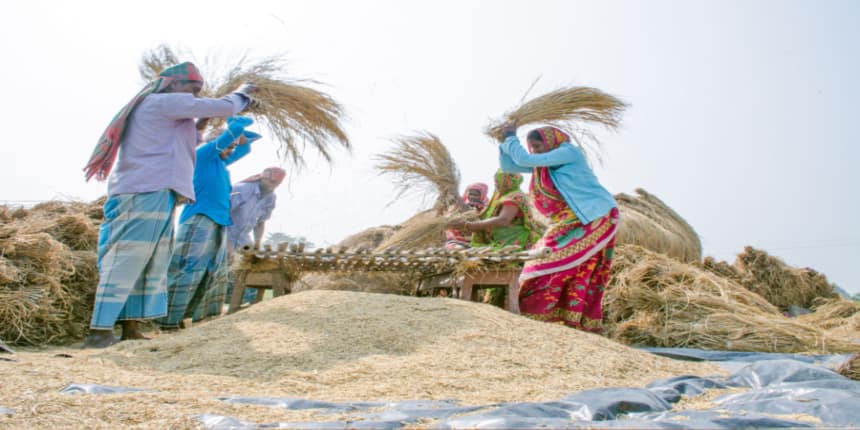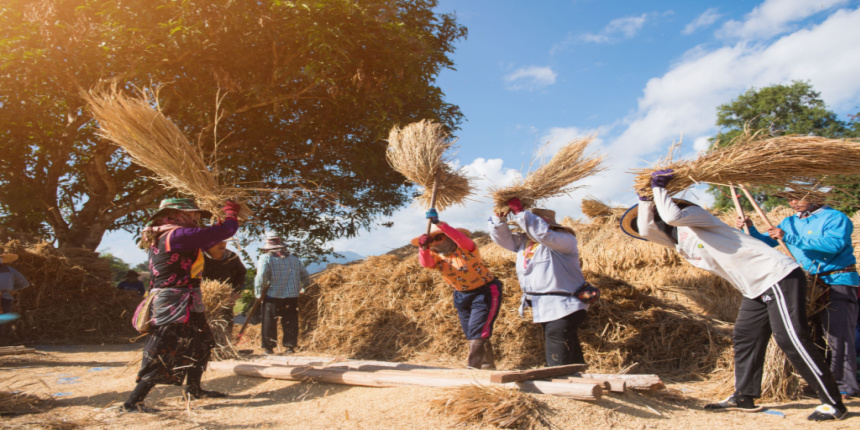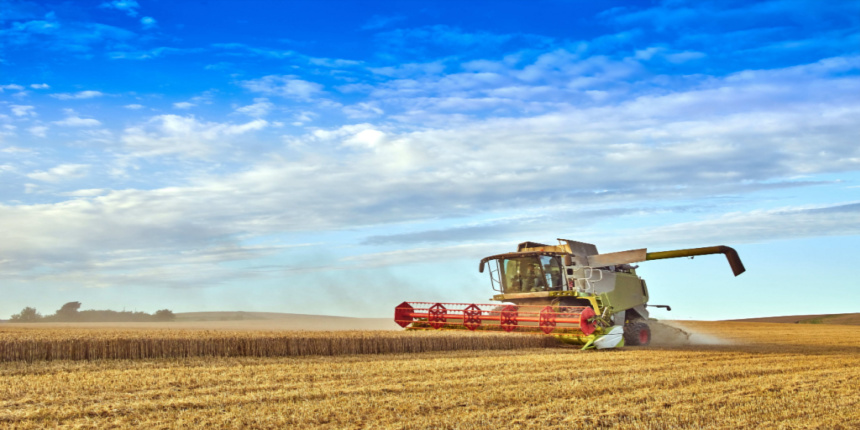1. What is the main difference between threshing and winnowing?
Threshing separates the grains from the stalks and husks, while winnowing separates the grains from lighter impurities like chaff and dust after threshing.
2. Why was the invention of the threshing machine important for agriculture
The threshing machine greatly reduced manual labor and time, minimized grain loss, and increased the efficiency of harvesting, which allowed farmers to process large quantities of crops quickly.
3. How is winnowing done traditionally and mechanically?
Traditionally, winnowing is done by tossing grains into the air so that the wind carries away lighter chaff. Mechanically, winnowing is done using blowers or air separators that blow away the lighter particles.
4. What role does threshing play in post-harvest processing?
Threshing is a crucial step that prepares harvested crops for further cleaning, drying, storage, and sale by removing the grain from the plant material.
5. What are some common crops that require threshing and winnowing?
Crops like wheat, rice, barley, maize, millet, and pulses typically undergo threshing and winnowing.
6. What are common methods of threshing?
Common threshing methods include beating with flails, treading by animals, using mechanical threshers, and modern combine harvesters that thresh and winnow simultaneously.
7. Can threshing be done manually?
Yes, threshing can be done manually using tools like flails or by beating harvested crops against hard surfaces. However, this method is labor-intensive and less efficient than mechanical threshing.
8. What is the principle behind mechanical threshing?
Mechanical threshing uses rotating cylinders or drums with teeth or spikes to separate grain from stalks and husks through impact, friction, and shaking motions.
9. How has threshing technology evolved over time?
Threshing has evolved from manual methods to animal-powered devices, then to stationary mechanical threshers, and finally to modern combine harvesters that perform multiple harvesting tasks simultaneously.
10. What is the environmental impact of different threshing methods?
Manual threshing has minimal environmental impact but is labor-intensive. Mechanical threshing is more efficient but may consume fossil fuels and produce emissions. Some modern threshers are designed to be more environmentally friendly.
11. How does crop moisture content affect threshing?
Optimal crop moisture content is crucial for effective threshing. Too much moisture can lead to incomplete separation, while overly dry crops may result in grain damage or loss.
12. What is the role of threshing in food security?
Threshing plays a vital role in food security by efficiently processing harvested crops, reducing post-harvest losses, and preparing grains for storage or distribution.
13. How does threshing contribute to the concept of purity in chemistry?
Threshing contributes to purity by separating desired grains (pure substance) from unwanted plant materials (impurities), aligning with the chemical concept of purification and separation of mixtures.
14. What is the difference between stationary threshers and combine harvesters?
Stationary threshers are fixed machines that thresh harvested crops brought to them, while combine harvesters perform cutting, threshing, and winnowing in a single pass through the field.
15. How does the principle of density difference apply to threshing and winnowing?
While threshing primarily uses mechanical force, the subsequent winnowing process utilizes density differences. Heavier grains fall straight down, while lighter chaff is blown away by air currents.
16. What is threshing?
Threshing is the process of separating grain or seeds from the stalks and husks of harvested crops. It involves beating or shaking the plant to loosen and remove the edible parts from the inedible chaff.
17. How does threshing relate to the concept of heterogeneous mixtures?
Harvested crops are heterogeneous mixtures of grains, stalks, and chaff. Threshing is a method of separating components of this heterogeneous mixture based on physical properties.
18. How does the concept of force and impact apply to threshing?
Threshing relies on applying force and impact to break the connection between grains and plant structures. The force must be sufficient to separate grains without damaging them.
19. What role does friction play in the threshing process?
Friction is crucial in threshing as it helps separate grains from husks and stalks. In mechanical threshers, the friction between the crop and threshing surfaces aids in loosening and removing grains.
20. How does threshing relate to the concept of mechanical energy in physics?
Threshing converts mechanical energy (from manual labor, animals, or engines) into the work of separating grains from plant material, demonstrating energy transformation principles.
21. How does threshing differ from winnowing?
Threshing separates grain from stalks and husks, while winnowing separates the lighter chaff from the heavier grain. Threshing is typically done first, followed by winnowing to further clean the grain.
22. How does threshing affect grain quality?
Proper threshing preserves grain quality by minimizing damage to kernels. Improper threshing can lead to cracked or broken grains, reducing their value and storage life.
23. Why is threshing important in agriculture?
Threshing is crucial for efficiently separating edible grains from inedible plant parts, making harvesting more productive and preparing crops for storage or further processing.
24. How does threshing relate to the concept of separation of mixtures?
Threshing is an example of mechanical separation, a method used to separate mixtures based on physical properties. It separates grain (desired component) from plant debris (undesired components).
25. What factors affect threshing efficiency?
Factors affecting threshing efficiency include crop moisture content, machine settings, crop variety, and maturity level of the harvested plants.
26. What are the challenges in designing universal threshing machines?
Designing universal threshing machines is challenging due to variations in crop types, sizes, and threshing requirements. Adaptability and adjustable components are key considerations.
27. What is the relationship between threshing and crop breeding?
Crop breeding often considers ease of threshing as a desirable trait, leading to the development of varieties that are more efficiently processed, impacting agricultural practices and yields.
28. What are the environmental considerations in modern threshing practices?
Modern threshing practices consider environmental impacts, focusing on energy efficiency, reducing emissions, and minimizing soil compaction during harvesting and threshing operations.
29. What safety precautions should be taken during threshing?
Safety precautions include wearing protective gear, ensuring proper machine maintenance, keeping limbs away from moving parts, and following manufacturer guidelines for equipment operation.
30. Can threshing be applied to substances other than grains?
While primarily used for grains, threshing principles can be applied to separate seeds from pods in various crops, such as legumes or oilseeds.
31. What is the impact of over-threshing on grain quality?
Over-threshing can damage grains, leading to cracked or broken kernels. This reduces grain quality, market value, and storage life, and can increase susceptibility to pests and mold.
32. How does threshing efficiency vary among different crop types?
Threshing efficiency varies based on crop characteristics such as stalk strength, grain attachment, and husk toughness. Some crops, like rice, require specialized threshing techniques.
33. What is the relationship between threshing and sustainable agriculture?
Efficient threshing contributes to sustainable agriculture by maximizing crop yield, reducing waste, and minimizing energy consumption in post-harvest processing.
34. How do modern threshing machines incorporate the principles of simple machines?
Modern threshing machines incorporate simple machine principles such as levers, wheels, and inclined planes to enhance efficiency in separating grains from plant material.
35. What is the role of centrifugal force in some threshing machines?
Some threshing machines use centrifugal force to separate grains from stalks and husks. The rotating motion throws heavier grains outward while lighter materials remain closer to the center.
36. What are the challenges in threshing small-seeded crops?
Small-seeded crops present challenges in threshing due to their size and potential for loss. Special care and adjusted equipment settings are often required to minimize seed damage and loss.
37. What is the significance of threshing in the context of food processing?
Threshing is a primary step in food processing for many grains, preparing them for further refinement, packaging, or direct consumption by removing inedible plant parts.
38. How does threshing contribute to the study of plant morphology?
Threshing provides insights into plant morphology by demonstrating how grains are attached to plants and the structures that hold them, contributing to botanical understanding.
39. What is the role of air flow in some threshing machines?
Some threshing machines incorporate air flow to aid in separating lighter chaff from heavier grains, combining threshing and initial winnowing in one process.
40. How does threshing efficiency affect agricultural economics?
Threshing efficiency directly impacts crop yields and quality, influencing farmers' income and overall agricultural productivity, thus playing a significant role in agricultural economics.
41. What are the differences in threshing requirements for wet and dry crops?
Wet crops often require more force for threshing and may need additional drying steps. Dry crops are generally easier to thresh but may be more prone to shattering and grain damage.
42. How does the concept of friction coefficient apply to threshing?
The friction coefficient between grains and threshing surfaces affects separation efficiency. Optimal friction allows for effective grain removal without causing damage.
43. What is the importance of adjustable settings in threshing machines?
Adjustable settings allow threshing machines to be optimized for different crop types, moisture levels, and desired outcomes, enhancing versatility and efficiency.
44. How does threshing relate to the concept of work in physics?
Threshing demonstrates the physics concept of work, as force is applied over a distance to separate grains from plants, converting energy into useful output.
45. What role does vibration play in some threshing methods?
Vibration in threshing helps loosen grains from stalks and husks. Some machines use controlled vibration to enhance separation without causing excessive grain damage.
46. How does the principle of momentum transfer apply to threshing?
Threshing involves momentum transfer as moving parts (like flails or threshing cylinders) impact crop materials, transferring energy to separate grains from plant structures.
47. How does threshing efficiency impact food waste reduction?
Efficient threshing minimizes grain loss and damage during harvesting, contributing to food waste reduction by maximizing the usable yield from crops.
48. How does the concept of energy conservation apply to threshing?
Energy conservation in threshing involves minimizing energy input while maximizing grain separation efficiency, often through improved machine designs and operational techniques.
49. What are the implications of incomplete threshing?
Incomplete threshing results in grain loss, as some grains remain attached to stalks or husks. This reduces overall yield and can impact the economic viability of harvesting.
50. How does threshing relate to the study of biomechanics?
Threshing exemplifies biomechanical principles by demonstrating how mechanical forces can be applied to biological materials (plants) to achieve desired separation outcomes.
51. What is the significance of threshing in the context of agricultural automation?
Threshing plays a crucial role in agricultural automation, with advanced machines integrating sensors and control systems to optimize the process for different crops and conditions.
52. How does the concept of material properties apply to threshing?
Understanding material properties of both crops and threshing surfaces is crucial for effective threshing. Properties like hardness, elasticity, and surface texture influence separation efficiency.
53. How does threshing contribute to the study of plant biomechanics?
Threshing provides insights into plant biomechanics by demonstrating the forces required to separate grains from plants, informing both agricultural practices and botanical research.
54. What is the role of threshing in seed quality control?
Threshing is a critical step in seed quality control, as proper techniques ensure seeds are separated without damage, maintaining their viability for planting or processing.
55. How does the principle of selective separation apply to threshing?
Threshing demonstrates selective separation by exploiting differences in physical properties between grains and other plant parts, allowing for efficient isolation of the desired crop component.




